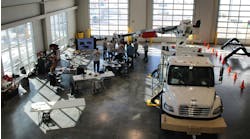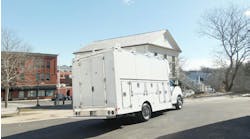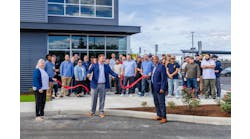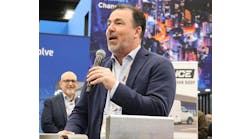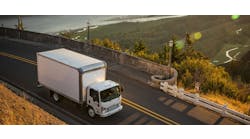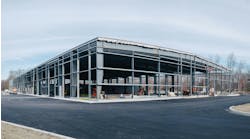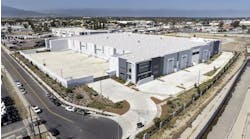Wilcox Bodies Ltd. has been in business since 1962, and the company’s success is rooted in a simple concept: Find out what customers need and give it to them. But even as Wilcox honors every request they can, increasingly customers want one thing in particular: aluminum truck bodies.
Wilcox Bodies got its start in aluminum simply enough: A customer suggested it.
“Wilcox has always said ‘We can make anything,’ so it just took some figuring out,” Vice President Dave Dick said. “If this bends, will it break? What are the differences in densities, and what dies do we have to have? It was just trial and error until we decided, ‘Hey, we can do this.’”
Indeed, at one point Wilcox offered products “across the board” in steel, aluminum and fiberglass—“whatever the customer wants,” Dick recalls.
Fiberglass largely fell by the wayside, however, because it didn’t afford the customization options Wilcox needed. Dick estimates aluminum bodies now make up 95% of the Wilcox business, a substantial shift.
Based in Milton ON, since 2008, Wilcox occupies a 32,000-sq.-ft. building on five acres just south of Toronto. Wilcox employs 55. The Dick family bought the company in 1980.
Wilcox products include basic service bodies; mechanics service bodies that include the crane, compressor and a multifunction power unit; aerial bodies, for which Wilcox builds the side packs; customized flatbeds, with different types of cranes; fire and rescue vehicles; and hi-rail trucks.
The company builds 350-400 units annually.
“We’ve been manufacturing aluminum for at least 40 of our 56 years. So it’s not like we’re just jumping on the lightweight, recycle bandwagon,” Dick says, and he points to Ford’s move to aluminum for the best-selling F-Series pickups as a difference maker. “Over the last 15 years, it was probably 20% aluminum, 80% steel at Wilcox. Now it’s gone the other way.”
The popular perception had been that aluminum is not strong, that it cannot “take the weight” for an application such as a mechanics body—“and it’s just not true,” Dick insists.
While work truck customers in Canada have gotten the message, on the U.S. side of the border it can still be a tough sale.
Industry veteran Andy deLivron joined Wilcox last year to focus on growing sales in the much larger U.S. market—about 90% of Wilcox sales are within Canada. While the natural market geography for Wilcox is the Northeast U.S., the company has sold products as far away as Florida and Texas. To hit growth targets, the U.S.—and aluminum—will be the key.
“We don’t build an aluminum can, we build an aluminum truck body. We use much heavier materials than our U.S. counterparts. As a result, it’s not a throwaway body,” deLivron says. “Many of our Canadian customers will buy a truck, use it for five to seven years, and recycle the body—refurb it—and take it for another seven years. Walking in for the first purchase, the price seems high. But if you can take that body and recycle it into another life, it becomes a low-cost product.”
Adds Dick: “We have a lot of customers who will change their chassis, take the body off and replace all of the external hardware, and remount it on a new truck.”
Weighing the cost
In addition to the question of the strength of aluminum compared to steel, deLivron also gets resistance on price.
Typically, the premium for an aluminum body runs 5-8%. But the equalizer, as DeLivron explains, is that the weight savings provide opportunities for customer. In a crane body, with a multifunction unit to power the crane, air compressor, hydraulic pack, etc., the weight savings of a Wilcox aluminum body provides means 5,200 pounds of carrying capacity—more than 1,000 pounds higher than similar steel bodies. And that’s a substantial improvement.
“In the U.S., I have been very successful in going into the ‘yellow-iron’ dealers and showing them the advantages of the weight savings,” deLivron says.
“You can start carrying bigger equipment, and that’s going to open the door to bigger jobs,” Dick adds. “Once they crossover, unless it’s an application where steel is required, they don’t go back.”
And looking a little further, that price difference is shrinking.
“Over the years, aluminum was way more expensive,” Dick says. “But, funny enough, as a body gets bigger, for aluminum the price becomes more reasonable. A big factor is that you don’t have to paint a lot of the area with aluminum.”
Another advantage to aluminum, especially in northern latitudes, is rust resistance. They key is knowing how to paint aluminum properly, and Wilcox has developed a multi-step process over the years: Sand and fill; a power phosphate wash followed by a hand phosphate wash; and two coats of Sherwin-Williams, at 4 mils wet and two coats of polyurethane finish.
This is in contrast to more typical high volume and “cheap” methods.
“I tell our customers that it’s very similar to what Freightliner uses on their cabs,” deLivron says. “After two years, you’ll start to see the difference.”
Aluminum is also a selling point for customers with sustainability programs. Wilcox bodies are made from aluminum that includes recycled material, and the when the body is done it can, in turn, be recycled entirely. Recent industry estimates, deLivron notes, say that approximately 90% of all aluminum going back to the 1940s has been recycled into new product.
And then there are the indirect benefits to aluminum and weight savings, such as fuel efficiency, tire wear, etc. While he doubts he’ll ever be able to do a formal study to confirm, Dick contends that the life-cycle savings for an aluminum body are “massive.”
Learning curve
The accelerating adoption of aluminum bodies in the marketplace means, of course, more competition for Wilcox. But Dick, again, points to the company’s decades of experience.
“[Our competitors] aren’t there yet with their product—they’re going to learn and the product will improve, but they’re not there,” he says. “We’ve gone through 35 years of crackings and splittings and whatever. Unfortunately, you have to learn as you go.”
Dick notes he can spot “right off the bat” future failure points on competitors’ new aluminum bodies. There’s the matter of metal compatibility and Galvanic corrosion, for starters.
“There’s definitely a learning curve. You can design, but there are everyday things where there are failures where you don’t expect a reaction. Stainless steel hardware and aluminum don’t like each other,” he says. “We have a whole team who focuses on this.”
At Wilcox, “everything that goes on a body” is mounted with spacers and isolators to prevent paint bubbling. He demonstrates a hinge Wilcox has developed over the years, one with which no washer, nut, or bolt touches the body.
“If you have some bubbling, it’s not going to do anything to the structure—but visually, for a customer, bubbling means the body is garbage,” Dick says.
For a lot of customers today, “appearance is everything,” deLivron adds. “Your branding is not only what you’re doing in marketing materials—your truck is marketing material. Image is important.”
And as great an option as aluminum is for many applications, steel bodies still have a place.
“We did learn over time that there are products where aluminum can go, and products where it can’t go,” Dick says, such as the largely off-road mining operations in parts of Canada. “There are just certain situations where you go with a steel body. And that’s a conversation we have to have with our customers.”
But even for applications that require a steel body, Wilcox will find others ways to take out weight with aluminum, such as truck doors. “You can have a steel body with aluminum doors and you’d never notice,” says Dick.
Indeed, walking into the reception area at Wilcox Bodies Ltd., a visitor can’t help but notice a display of three different truck doors—steel, aluminum, and a composite product by Eberhard Mfg. Co.—hanging on a rack. It’s a hands-on demonstration of weight savings.
“Visually you can’t see any difference, and the strength [of the composite doors] is insane,” Dick said.
Challenges
As with most trailer and truck body builders, finding qualified welders is a challenge for Wilcox—and aluminum makes staffing even more difficult. Because Wilcox also works with steel, all of its welders are CWB certified for both.
“Our welders and are processes are constantly being monitored by the CWB, Canadian Welding Bureau. Our processes as well as our welders are recertified every 6 months. [under the certification standards],” deLivron says. “As a result, we build a really high-quality product.”
And while the manufacturing floor does have some automation, the custom nature of most Wilcox bodies means robots won’t be replacing skilled labor any time soon, Dick notes.
All the bending and cutting is done at the facility, where the manufacturing floor features a state of the art paint booth, high tech manufacturing equipment and cranes. Wilcox mounts 60-70% of its bodies in Milton, with body shipments accounting for the rest.
Another challenge—and again, not unique to Wilcox—is the border.
For starters, unlike the big truck OEMs, U.S. automakers won’t provide drop-ship codes to the Canadian company. Having to route truck chassis through a middleman adds costs that U.S. competitors don’t face.
The strength or weakness of the U.S. dollar also impacts the sale of bodies to U.S. customers, and must be factored into pricing.
And while the Trump plan to impose tariffs on U.S. imports or steel and aluminum had not been proposed at the time of the Trailer/Body Builder visit to the Wilcox facility, deLivron subsequently said the company was still evaluating the details, and potential impacts—for better or worse.
Looking ahead
Dick is quick to emphasize the advantages of a family-owned and operated business.
“Though we’ve grown, we still have those family values. I’m on the floor. I deal with customers direct,” he says. “We don’t go through 20 levels to make a decision. We make our decisions with the customer. We get feedback, and we can make changes immediately. That’s a huge advantage, that’s where we thrive. I can sell a body, and that’s great—but if doesn’t meet the customer’s needs, then what’s the point. Then for some of those good ideas, we implement across the board.”
Such innovation and success with truck bodies has also led to other products. Wilcox now has an airline division focused on ground service vehicles, Dick noted.
And that is very much in keeping with the Wilcox way of doing business.
“Sometimes you don’t know what you’re getting into until you get into it,” Dick says. “But when someone asks you for something, it’s an opportunity.”
For more information on Wilcox Bodies Ltd.,
visit www.wilcoxbodies.com

